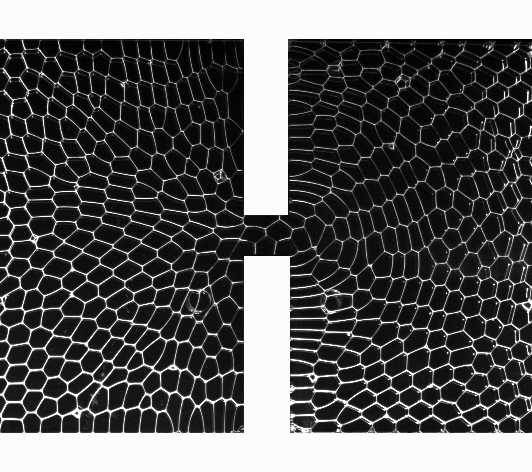The flow of aqueous foams in 2D geometries
Dr Mandar Badve, Michal Solarski, Prof. Mostafa Barigou
Project status: ongoing
The movement of three-dimensional gas-liquid foams through narrow channels of complex geometry, e.g. gradually/suddenly contracting/expanding, where both bulk and surface properties are important, is commercially challenging and technically important. Industries dependent on foam flow, e.g. ice-cream, shaving foam and polyurethanes, have expected global annual revenues as high as $74 billion by 2018. They enjoy a strong UK position and, consequently, process improvements arising from the proposed research have the potential to generate multi million pounds savings.
In our work, we seek to elucidate experimentally the phenomenon associated with the flow of 3D aqueous gas-liquid foams through 2D narrow channels containing a variety of constrictions or expansions. We started with straight 2D channels similar to the well-known Hele-Shaw cell, made of two long and wide parallel Perspex plates, but separated by an adjustable narrow gap so that one or several bubble layers of foam can be accommodated. The channel contains gradually/suddenly contracting/expanding geometries.
The following animations show the flow behaviour of a single layer of foam through gradually/suddenly contracting/expanding geometry in a Hele-Shaw cell. We examine foam behaviour as a function of flowrate, initial bubble size and flow constriction geometry. The effects on the entire flow field including foam morphology, liquid holdup, pressure drop and velocity profile are analysed. We examine individual bubble motion and deformation using a “texture tensor”. We, thus, explore the parameter space to obtain the local strain and stress fields and determine transition from elastic to plastic deformation.
 |
 |
| Figure 1: Flow of foam through a gradual contraction and expansion | Figure 2: Flow of foam through a sudden contraction and expansion |
In another part of the project, we are studying well-controlled foam flows (e.g. fixed bubble size, gas-liquid fraction or gas and liquid flowrate) in microfluidics channels that also contain some sort of constriction such as sudden contraction followed by expansion or gradual contraction followed by expansion. Effects of type of constriction on bubble behaviour (morphological changes and bubble break-up) as well as the effect of liquid rheological properties are studied and described using dimensionless analysis. This project should improve a general knowledge of foam flow through complex geometries.
 |
| Figure 3 - Flow of foam through a gradual contraction and expansion in a microfluidic channel |
 |
| Figure 4 - Flow of foam through a sudden contraction and expansion in a microfluidic channel |
